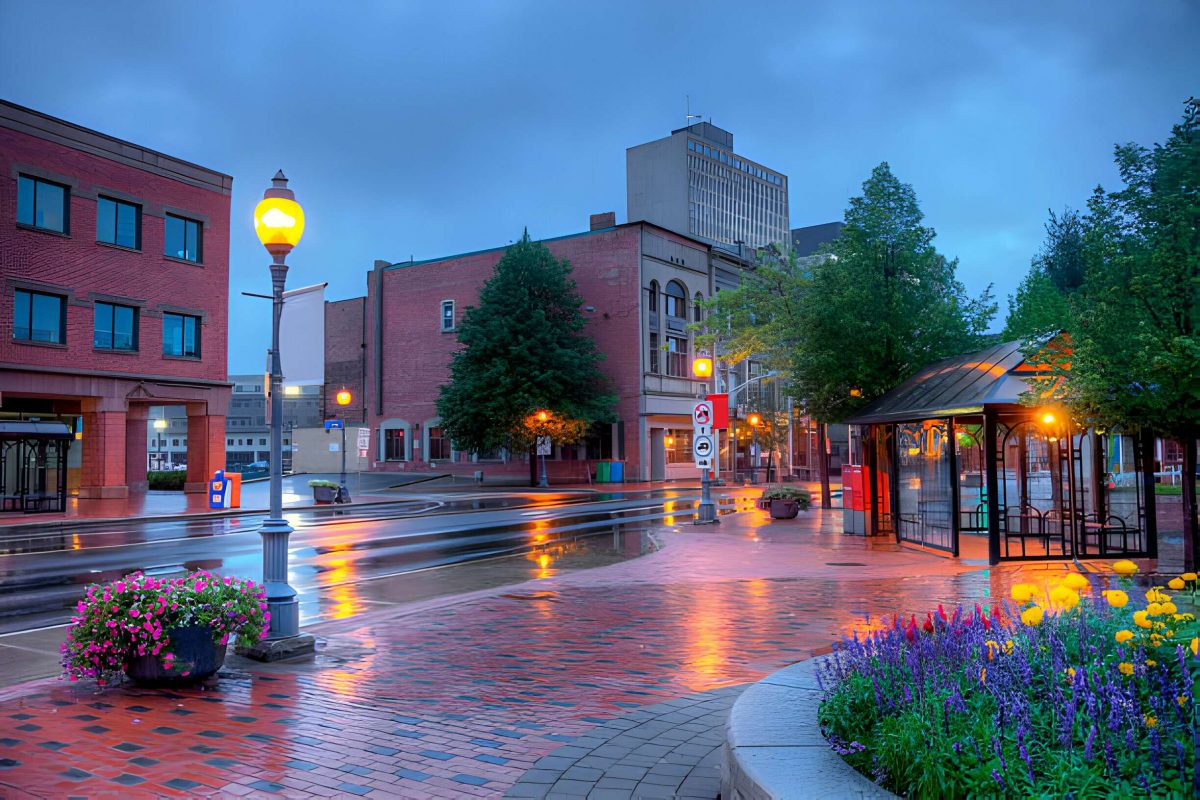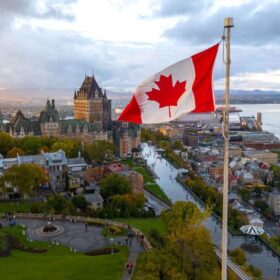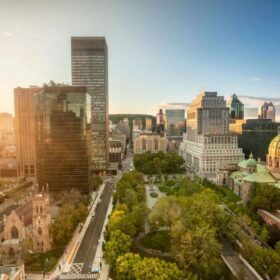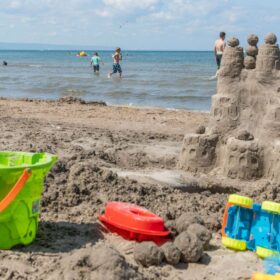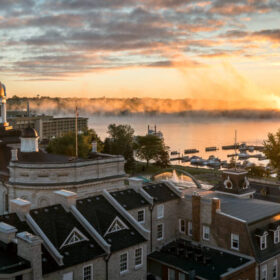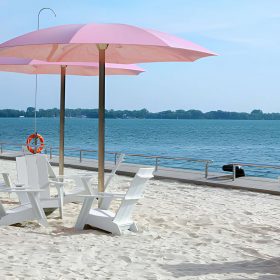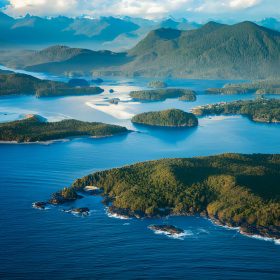Moncton, situated at the end of the narrow Petitcodiac River estuary where it meets the Bay of Fundy, stands as one of the largest cities in New Brunswick.
Renowned for its numerous parks, one of which provides an optimal vantage point for witnessing the daily spectacle of the Tidal Bore, where changing tides surge up the estuary in a frothing wall of water, Moncton offers a range of natural attractions for visitors. These include the iconic Hopewell Rocks, accessible for walking under during low tide and kayaking around as the tide rises. Alternatively, one can unwind on the expansive sandy beaches along the Northumberland Strait. Families can enjoy various attractions like the zoo, water park, and science museum.
Moncton also boasts a vibrant French cultural scene, rooted in the heritage of Acadians descended from French colonists who initially settled in the early 1700s. To delve into their culture, visitors can explore the Acadian Museum.
Serving as a hub with numerous hotels and restaurants, Moncton makes an excellent base for exploring the captivating region of New Brunswick. Explore the myriad things to do in Moncton with this comprehensive list.
1. Bay of Fundy Tidal Bore
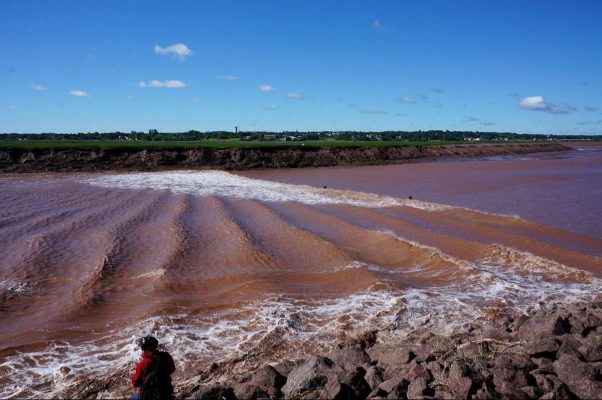
Twice a day, the rising tide surges through the Bay of Fundy, generating some of the world’s highest tides. The powerful ebb and flow of seawater have endowed this coast with captivating attractions, including Moncton’s Tidal Bore.
As the water rushes into the Petitcodiac estuary, its banks of dark brown mud resemble an intricately carved bed of chocolate during low tide. A meter-high wave swells, transforming the estuary into a vast lake and covering nearby mudflats and salt marshes.
In Moncton, the narrow, muddy riverbed undergoes a remarkable transformation, turning into a 7.5-meter-deep river within an hour. Tidal Bore Park in the city’s downtown stands as the prime location to witness this natural phenomenon, featuring a clock indicating when to expect the next bore.
For a period, Moncton’s iconic attraction faced the threat of disappearance when a causeway disrupted the flow of the tidal river. However, its removal has successfully reinstated the renowned Tidal Bore.
Riverside Park, a larger park located at the opposite end of the downtown area, offers walking trails and picnic tables with views of the river. Additionally, it houses the bronze RCMP Monument, paying tribute to police officers killed in the line of duty.
2. Coast up Magnetic Hill

Located just northwest of Moncton, Magnetic Hill stands as one of Canada’s most frequented natural wonders, earning its place on the Canadian Register of Historic Places as a longstanding tourism icon. The allure of Magnetic Hill lies in the intriguing illusion that a car, placed in neutral with brakes released, is mysteriously pulled uphill. The question naturally arises: how can this phenomenon occur?
Magnetic Hill is essentially an optical illusion resulting from the topography of the surrounding terrain. In reality, the car is not ascending uphill; however, the grade and contours of the landscape create a visual perception that tricks the observer into thinking otherwise. Adjacent to Magnetic Hill, the Magnetic Hill Wharf Village serves as a tourist hub with a collection of shops and restaurants, artfully designed to resemble an antiquated maritime fishing village.
3. Explore the Dunes at Bouctouche
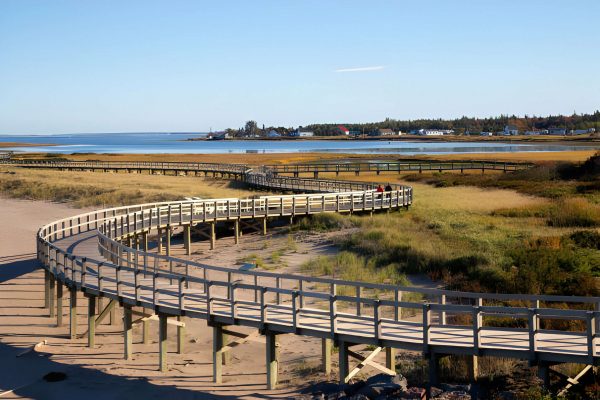
Bouctouche, situated approximately 50 kilometers north of Moncton, embodies a traditional Acadian fishing community and is the location of La Dune de Bouctouche, one of the last remaining sand dunes on the northeast coast of North America. Stretching across Bouctouche Bay, this dune serves as a crucial marine habitat and can be explored via a broad boardwalk that spans a significant portion of its length.
The Irving Eco-Centre offers insights into the dunes, local wildlife, and habitat preservation through ranger-led tours and an interpretation center. Particularly engaging for children, the center features telephones allowing them to listen to bird calls.
Nearby, Le Pays de la Sagouine is a delightful theatrical town designed to honor the fictional universe crafted by Antonine Maillet. Transforming a small island into the Depression-era hometown of La Sagouine, Maillet’s central character, the site’s houses and shops are filled with authentic artifacts from that period. This unique destination combines elements of a living history museum and an amusement park. While the character interactions are in French, the performances and the opportunity to experience genuine Acadian music are enjoyable for all visitors.
4. Fort Beauséjour National Historic Site
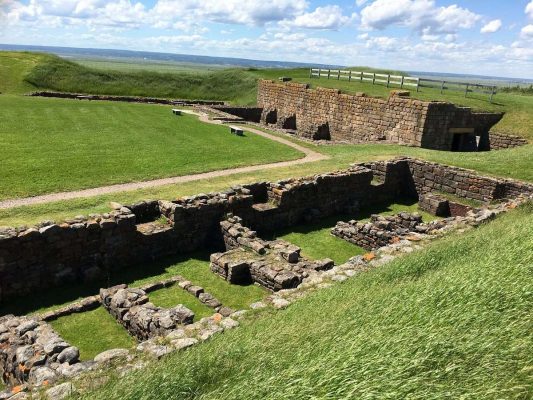
Fort Beauséjour, located southeast of Moncton near the Nova Scotia-New Brunswick border, is a national historic site with roots in French settlement during the latter part of the 17th century when the land was known as “Beau Bassin.” Following the Treaty of Utrecht in 1713, the region transitioned to the control of the Scots and English, establishing a border akin to the current provincial boundary between British Nova Scotia (New Scotland) and French Acadia.
Fort Beauséjour was constructed by the French on their side, while the British erected Fort Lawrence on theirs. In 1755, the British seized Fort Beauséjour and expelled the French-speaking Acadians who refused to pledge allegiance to the Crown.
Visitors can explore the earthworks, casemates, and remnants of the star-shaped fort, delving into the history of settlers and soldiers through captivating artifacts and exhibits. The site offers panoramic views over the Cumberland Basin and Chignecto Bay.
Thanks to its ridgetop location, Fort Beausejour is a popular spot for flying kites. While in Aulac, you can follow signs to the Sun Maze at Trueman Blueberry Farms on Etter Ridge Road. This unique variation of a corn maze features a vibrant field densely planted with sunflowers, providing a visually striking experience, even if you choose not to navigate through the sunflower maze.
5. Kayak around Hopewell Rocks at High Tide
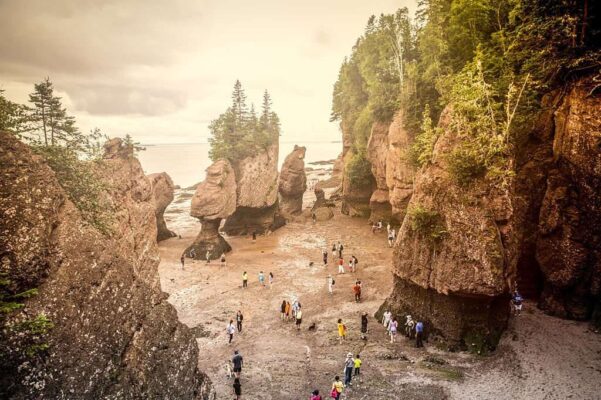
The tides of the Bay of Fundy inundate the marshes around Moncton, but at Hopewell Cape, they have intricately shaped sea stacks known as the Hopewell Rocks or Flowerpot Rocks. These tide-carved pillars stand tall while the adjacent high cliffs succumb to erosion by the Fundy tides.
Some of these pillars soar up to 21 meters above the ocean floor, still adorned with the trees and plants that once graced the cliff tops. The combination of these trees, the terracotta hue of the rocks, and the slender bases of the pillars gives them the appearance of colossal flowerpots, hence the nickname.
During high tide, the water submerges everything except the tree-covered summits, visible from a viewing platform. At low tide, you can descend the extensive flights of steps to the sea floor and stroll among these formations. Alternatively, you can opt for a guided kayak tour to paddle among them during high tide.
In Hopewell Cape, you’ll also find the Albert County Museum, which focuses on local history. The heritage buildings and artifacts at the museum offer insights into the region’s pioneer shipbuilding and logging heritage.
6. Swim at Parlee Beach Provincial Park
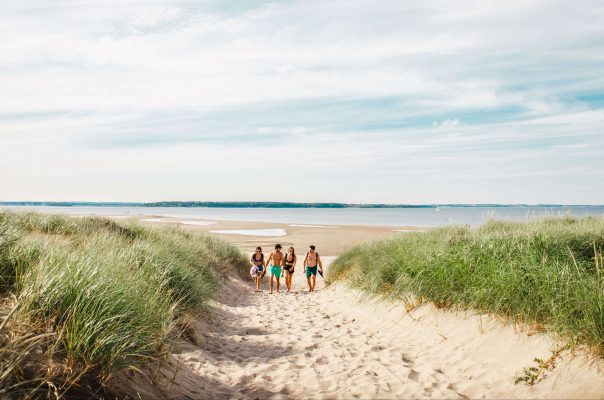
Located on the Northumberland Strait, to the north of Moncton, Parlee Beach Provincial Park in Shediac boasts one of the most splendid sandy beaches along Canada’s Atlantic coast. Additionally, during the summer, the relatively shallow water in this area can reach temperatures as warm as 20 degrees Celsius (68 degrees Fahrenheit). With its expansive white sands and gentle waves, Parlee Beach Provincial Park provides amenities like changing facilities, picnic areas, and a campground.
The neighboring town of Shediac proudly declares itself as the lobster capital of the world, a claim emphasized by the presence of a giant lobster statue near the visitor information center. You can expect to indulge in fresh seafood at one of the numerous restaurants lining the shoreline here.
7. Get Hands-on at Resurgo Place
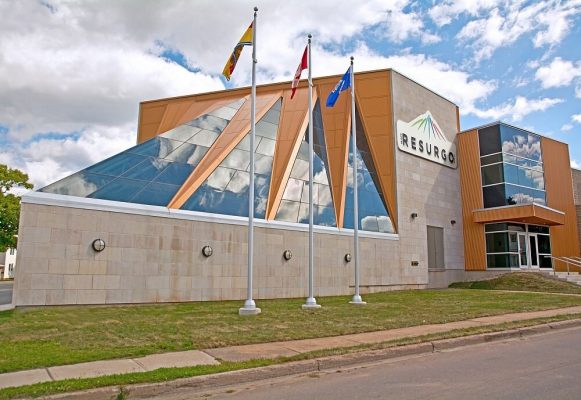
Although primarily designed with children in mind, Resurgo Place, a history and science discovery center/museum, offers plenty of engaging and entertaining elements for adults as well. The interactive exhibits at Resurgo Place primarily focus on transportation, shedding light on Moncton’s historical significance as a hub for rail and shipbuilding. Visitors can partake in hands-on activities such as testing aircraft in a wind tunnel, constructing, and racing small boats, and exploring the mechanics of gears and pulleys.
The museum showcases artifacts from Moncton’s past, providing insights into life from the times of the Mi’kmaq to the present. Exhibits also delve into the history of early Acadian farms. A notable centerpiece of the museum is a large interactive map of Moncton.
8. Watch Birds in Sackville
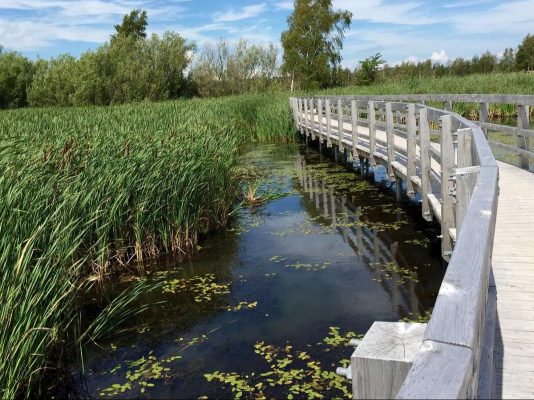
Sackville, situated just five minutes from the Nova Scotia border on the Tantramar Marshes, boasts a remarkable environment for bird-watching due to its expansive marshland, providing an ideal habitat for birds.
The Sackville Waterfowl Park features 2.5 miles of boardwalks and walking trails across its 55-acre expanse of woods, water, marsh, and meadows. Here, you can encounter over 180 bird species and 200 plant varieties. A brochure, obtainable at the tourist office, offers a checklist for documenting your bird sightings.
Known as an arts hub, Sackville provides a self-guided Sackville Arts Walk brochure, guiding you to galleries, public artworks, and museums, including the Owens Art Gallery on the Mount Allison University campus, home to a permanent collection of over 3,000 works.
Adding to its historical allure, Sackville hosts the intriguing Campbell Carriage Factory Museum, originally a tannery transformed into a carriage factory in the mid-19th century. This museum showcases a collection of more than 6,000 artifacts related to horse-drawn vehicles, agricultural equipment, and caskets.
9. Centennial Park
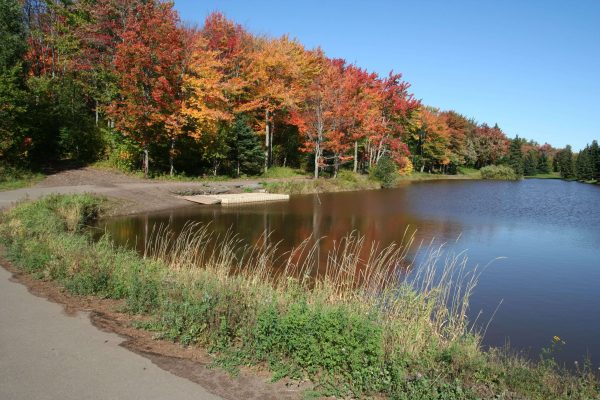
The expansive park situated in the heart of Moncton combines wooded areas with open recreational spaces, providing a range of activities throughout the year. In 2019, a new swimming pool and beach area, complete with a wading pool for children, were introduced. Additionally, the park features picnic facilities, lawn bowling, tennis courts, playgrounds, and both gravel and paved trails catering to hikers and cyclists.
During the winter months, the park remains a popular destination for activities such as ice-skating, snowshoeing, tobogganing, and skiing, boasting Eastern Canada’s longest-lighted cross-country ski trail.
10. Meet the Tigers at Magnetic Hill Zoo

Spread across 40 acres, the Magnetic Hill Zoo stands as the largest in Atlantic Canada, housing nearly 600 animals of both indigenous and exotic origins. The diverse collection encompasses African lions and Amur tigers, alongside native species like white-tailed deer and woodland caribou.
Among the array of inhabitants are various big cats such as jaguars and Amur leopards, as well as exotic creatures like anteaters, tamarins, elands, lemurs, and a variety of monkeys. The aviary section boasts peacocks, Caribbean flamingos, toucans, and cockatoos.
The zoo is organized into distinct areas mirroring different habitats, including the Americas, Asia, Africa, and the Discovery Centre. Adding to its appeal for families, there is an expansive three-level playground for children to enjoy.
11. Hike in Irishtown Nature Park
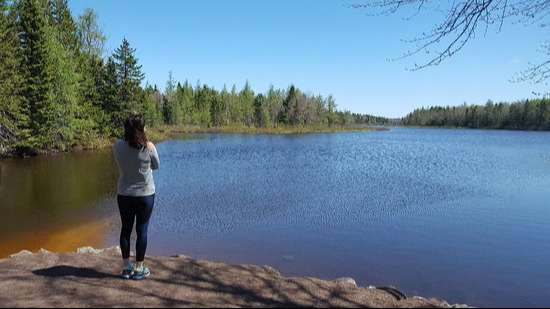
One of Canada’s extensive urban parks, Irishtown Nature Park boasts an intricate network of meticulously maintained walking trails and bike paths weaving through the forest and encircling a lake. Most of the trails are level, with approximately half featuring surfaces suitable for strollers and wheelchairs. These pathways are regularly cleared during the winter, while natural trails are available for snowshoeing.
The park encompasses a diverse ecosystem comprising Acadian forests, marshlands, streams, and the lake, making it an ideal location for observing wildlife. Well-marked trails, accompanied by benches and restrooms, contribute to the park’s amenities, and a lake launch is provided for kayaks and canoes.
FAQs
Q: What is the best time to visit Magnetic Hill?
A: Magnetic Hill is enjoyable throughout the year, but summer (June to August) provides ideal weather for outdoor activities.
Q: Are there any family-friendly events at Centennial Park?
A: Yes, Centennial Park hosts various family-friendly events, including outdoor concerts, festivals, and seasonal celebrations.
Q: Can I experience tidal bore rafting in Moncton?
A: Absolutely! Several tour operators offer thrilling tidal bore rafting experiences for adventurous visitors.
Q: Are there any cultural festivals in Moncton?
A: Yes, Moncton hosts annual cultural festivals like the Frye Festival, celebrating literature and storytelling.
Q: What’s the best way to explore Irishtown Nature Park?
A: The park offers well-marked trails for walking and hiking, providing an immersive experience in nature.

